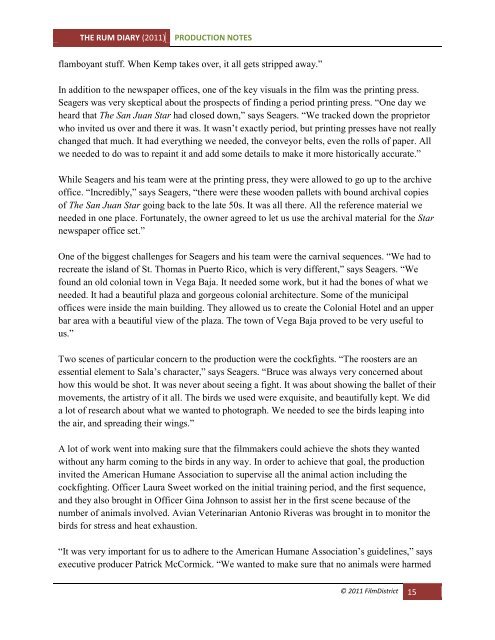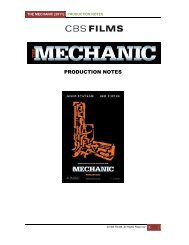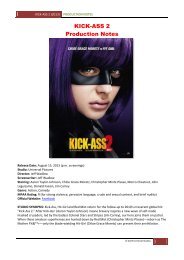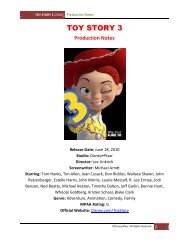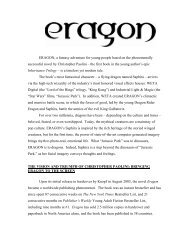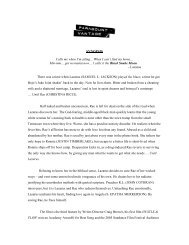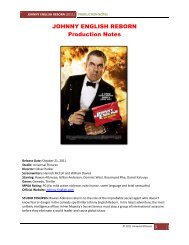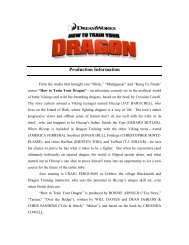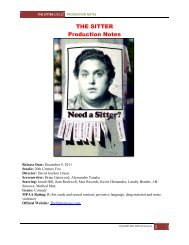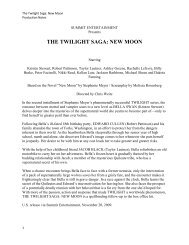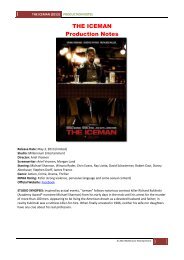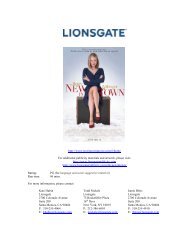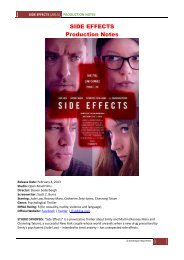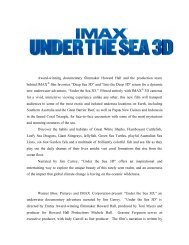THE RUM DIARY Production Notes - Visual Hollywood
THE RUM DIARY Production Notes - Visual Hollywood
THE RUM DIARY Production Notes - Visual Hollywood
Create successful ePaper yourself
Turn your PDF publications into a flip-book with our unique Google optimized e-Paper software.
<strong>THE</strong> <strong>RUM</strong> <strong>DIARY</strong> (2011)<br />
PRODUCTION NOTES<br />
flamboyant stuff. When Kemp takes over, it all gets stripped away.‖<br />
In addition to the newspaper offices, one of the key visuals in the film was the printing press.<br />
Seagers was very skeptical about the prospects of finding a period printing press. ―One day we<br />
heard that The San Juan Star had closed down,‖ says Seagers. ―We tracked down the proprietor<br />
who invited us over and there it was. It wasn‘t exactly period, but printing presses have not really<br />
changed that much. It had everything we needed, the conveyor belts, even the rolls of paper. All<br />
we needed to do was to repaint it and add some details to make it more historically accurate.‖<br />
While Seagers and his team were at the printing press, they were allowed to go up to the archive<br />
office. ―Incredibly,‖ says Seagers, ―there were these wooden pallets with bound archival copies<br />
of The San Juan Star going back to the late 50s. It was all there. All the reference material we<br />
needed in one place. Fortunately, the owner agreed to let us use the archival material for the Star<br />
newspaper office set.‖<br />
One of the biggest challenges for Seagers and his team were the carnival sequences. ―We had to<br />
recreate the island of St. Thomas in Puerto Rico, which is very different,‖ says Seagers. ―We<br />
found an old colonial town in Vega Baja. It needed some work, but it had the bones of what we<br />
needed. It had a beautiful plaza and gorgeous colonial architecture. Some of the municipal<br />
offices were inside the main building. They allowed us to create the Colonial Hotel and an upper<br />
bar area with a beautiful view of the plaza. The town of Vega Baja proved to be very useful to<br />
us.‖<br />
Two scenes of particular concern to the production were the cockfights. ―The roosters are an<br />
essential element to Sala‘s character,‖ says Seagers. ―Bruce was always very concerned about<br />
how this would be shot. It was never about seeing a fight. It was about showing the ballet of their<br />
movements, the artistry of it all. The birds we used were exquisite, and beautifully kept. We did<br />
a lot of research about what we wanted to photograph. We needed to see the birds leaping into<br />
the air, and spreading their wings.‖<br />
A lot of work went into making sure that the filmmakers could achieve the shots they wanted<br />
without any harm coming to the birds in any way. In order to achieve that goal, the production<br />
invited the American Humane Association to supervise all the animal action including the<br />
cockfighting. Officer Laura Sweet worked on the initial training period, and the first sequence,<br />
and they also brought in Officer Gina Johnson to assist her in the first scene because of the<br />
number of animals involved. Avian Veterinarian Antonio Riveras was brought in to monitor the<br />
birds for stress and heat exhaustion.<br />
―It was very important for us to adhere to the American Humane Association‘s guidelines,‖ says<br />
executive producer Patrick McCormick. ―We wanted to make sure that no animals were harmed<br />
© 2011 FilmDistrict 15


